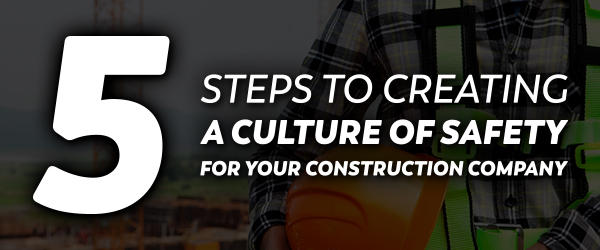Building a safe workplace takes time and patience. It involves changing both internal and external processes, organizational culture, and the rules by which your small business functions. More importantly, it should start at the top.
“Safety first” must be more than a slogan for your construction company. It’s a system of belief that should be internalized by executives, middle management, and crew members alike, and it should be accepted as a core principle.
The numbers paint a grim picture. As the construction industry has been recovering from the recession, more and more work injuries have occurred. In 2015 alone, there were 937 fatal work injuries.
The following five practices can help you create a culture of safety and ensure increased safety for your workers.
Make Safety Your Top Commitment
As a business leader, you can set s standard of safety in your company and show everybody down the ladder that you care. More than reducing costs, increasing productivity, and meeting deadlines, safety is what makes you successful. A safe work environment is conducive of confidence and trust in the management, which means that workers will not only be healthier but also more loyal.
When it comes to costs, safety measures may seem pricey at first, but they will save you a lot of money in the long run. Just think about it: you will lose fewer work days due to accidents and injuries, insurance costs will go down, and you will have fewer overruns and delays.
Communicate your commitment to safety to your workers and be an example in the way you conduct yourself. If you tell them to use safety equipment, but you don’t bother to do it yourself, they won’t either.
Educate Management and Employees
The various levels within an organization are intertwined and must understand that safety is crucial. In order to help prevent accidents and teach your employees how to respond to a crisis, it is necessary to organize continuous and rigorous safety training. Educate your management on federal, state, and municipal policies and regulations and help them understand what the penalties are if they don’t abide by these rules. Let them know that the consequences will have a major impact, not just on the business but upon the well-being of employees.
Make sure to put systems and procedures in place in order to avoid labor-related hazards. In that way you can become a leader in construction workplace safety.
Include Employees in Safety Decisions
Who understands the dangers better than those who face them every day? Ask your employees what measures they think should be taken, and then include them in your safety plans. As a result, you will be able to create not only a culture of safety but also one of inclusion. Discuss concerns with your employees and develop guidelines everybody will stick to, not because they’re mandatory, but because workers feel that they are essential to their well-being.
Be Open and Transparent
People dislike policies and regulations because they are usually hard to find and comprehend. To create a culture of safety for your construction company, make sure that you are open and transparent. Induction training for new employees, for example, will have to include safe workplace practices, which sometimes means shadowing a senior employee who knows what needs to be done under what conditions.
It is equally important that your employees feel secure to report safety issues or voice their concerns. If they are ridiculed or face retribution, they may start hiding the truth about hazards, and this creates a disservice to your company. Facilitate dialog by setting up methods through which suggestions and concerns can be expressed. Make sure you respond to these ideas or inform employees what modifications have been included within company policies.
Monitor and Evaluate Policy Implementation
Developing good policies and having people on board is not enough to make sure accidents don’t happen. Sometimes, both management and employees become complacent, mostly because they feel that all safeguards are already in place and nothing bad can or will happen.
Monitor how safety policies are implemented and assess staff commitment. A culture of safety means that a company invites feedback from employees, reviews systems, and fine-tunes what doesn’t work. One way of keeping everybody on their toes is a carrot and stick system that rewards the safe behavior of workers (competitions, quizzes, points towards a voucher or local night out, etc.) and penalizes unsafe behavior.
When you instill in your management and employees the awareness that safety culture is critical for company development, you develop commitment to growing a secure and productive business. Safety measures provide a better working environment, improved staff morale, and reduce downtime due to accidents.
Communicate with your staff and include them in your decision-making process so that they feel that they are your top priority. Also, don’t forget to walk the talk; a robust safety culture starts with an owner and a management team following the same measures that are asked of everyone else within an organization.






